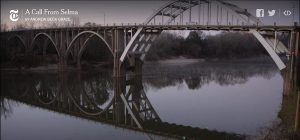
TUSCALOOSA, Ala. — Students in a new, interdisciplinary nonfiction studies course at The University of Alabama have collaborated with two faculty members in the College of Communication & Information Sciences to publish a New York Times Op-Doc film about the legacy of the voting rights struggle in Selma.
The short film, “A Call from Selma,” is part of a larger narrative project being produced in a service-learning course on nonfiction storytelling taught by Andrew Beck Grace and Chip Brantley.
The course, which was developed during a faculty fellowship in service-learning with the Center for Ethics and Social Responsibility, is part of a nascent Program in Nonfiction Storytelling.
Grace, who teaches in the telecommunication and film department and runs the Documenting Justice program, directed the film, a first-person account of the Rev. Clark Olsen, who was one of three white Unitarian Universalist ministers attacked in Selma March 9, 1965, during the tumultuous period after “Bloody Sunday.”
“We are all excited the piece will be seen widely by an international audience,” Grace said. “And Chip and I are very excited about how this project represents the high-quality, collaborative work the nonfiction storytelling program could do.“
Brantley, a lecturer in the journalism department, said students in the course were involved in every aspect of the documentary, from filming on location in Asheville, N.C., to researching, fact-checking and suggesting edits to the film.
Connor Towne O’Neill, a student in the course, is a Master of Fine Arts candidate in nonfiction and the director of Tuscaloosa Writers in the Schools.
“This course has been a master class in the craft of storytelling, the methods of research and interview, and the practice of engaged empathy,” O’Neill said. “It has changed the way I read, write, listen, look and think about myself in relation to history and my surroundings.”
The film was produced, in part, with funding from UA’s Creative Campus’ Creativity in Collaboration grant.
Dr. Mark Nelson, dean of the College of Communication & Information Sciences, said the project exemplifies the creativity of UA faculty and students and shows their abilities to compete in the ever-changing modern media environment.
“Any time we see students and faculty gain international exposure for their work, we feel extremely proud,” Nelson said. “The collaborative nature of this effort truly demonstrates the commitment of our faculty to providing the best education for our students and producing media products that compete with those coming out of any other college in the United States.”
The final project for the course, an immersive, web-based narrative, will be published to coincide with a live multimedia event Thursday, April 23, at the Dinah Washington Cultural Arts Center in downtown Tuscaloosa.
Contact
Misty Mathews, UA Media Relations, 205/348-6416, mmathews@ua.edu
Source
Chip Brantley, 205/348-4692, chip.brantley@ua.edu